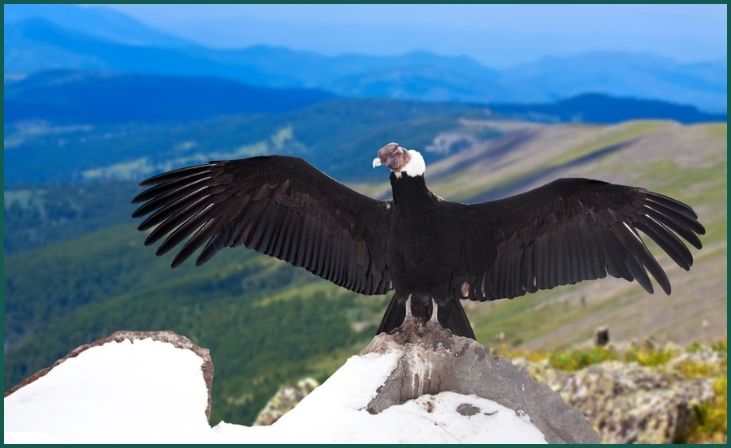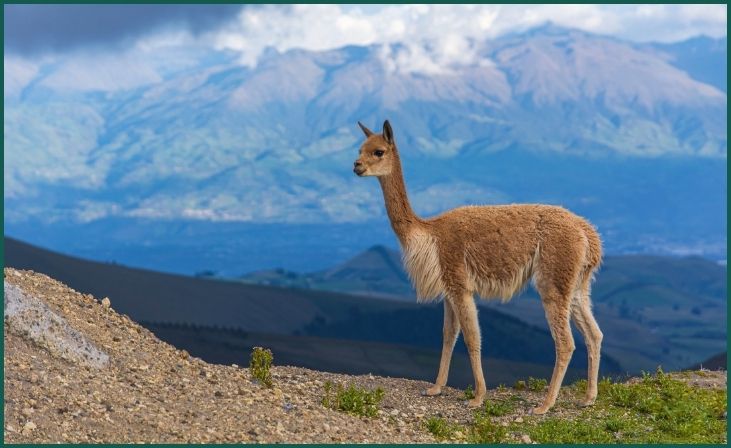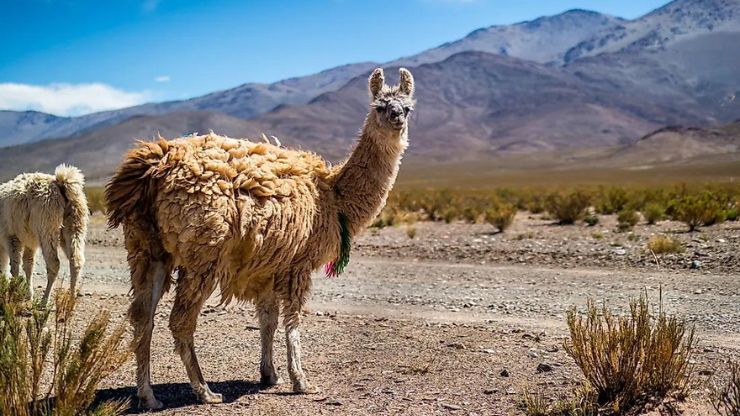Welcome to our exploration of “7 Remarkable Animals That Live in the Andes Mountains.” Nestled along the western coast of South America, the Andes Mountains boast some of the most diverse and breathtaking ecosystems on the planet. From towering peaks to lush valleys, this mountain range is home to an array of unique and fascinating wildlife species that have adapted to its challenging terrain and extreme climates.
In this blog, we will take you on a journey to discover seven remarkable animals that call the Andes home. From the elusive Andean condor soaring high above the peaks to the adorable spectacled bear roaming the forests below, each creature offers a glimpse into the rich biodiversity and natural wonders of this iconic mountain range. Join us as we delve into the lives of these incredible Andean animals and explore the secrets of their mountain habitat.
Table of Contents
ToggleAnimals That Live in the Andes Mountains
Andean Condor

The Andean Condor, with its impressive wingspan and majestic presence, holds a significant place in the Andean ecosystem and culture. As captured by Michael Gäbler’s lens, the condor soaring against the backdrop of the Andes Mountains epitomizes the region’s wild beauty. Revered by indigenous peoples as a symbol of power and spirituality, the condor’s graceful flight adds to the mystique of the Andes, showcasing the harmony between nature and its inhabitants. Despite facing threats such as habitat loss and hunting, efforts to protect the Andean Condor have been ongoing, highlighting its importance as a flagship species for conservation in the region.
Gäbler’s photograph serves as a poignant reminder of the need to preserve the Andean Condor and its habitat for future generations to admire and appreciate.
Also Read- 7 Adorable Types of Bulldogs to Adopt for a Loving Furry Friend
Llama
Alonso Paredes’ depiction of the Llama grazing serenely amidst the Andean landscape captures the essence of this iconic animal’s role in the region. Llamas have been domesticated by indigenous peoples of the Andes for thousands of years, serving as pack animals, sources of wool, and even companions. Their distinctive appearance and gentle demeanor make them a beloved fixture in the Andean highlands. Paredes’ photograph not only showcases the Llama’s contribution to the breathtaking scenery of the Andes but also highlights its cultural and economic significance to the communities that call this rugged terrain home.
With their ability to thrive in harsh conditions and traverse steep mountain slopes, Llamas embody resilience and adaptability, making them an integral part of Andean life.
Spectacled Bear
Anil Öztas’ exploration of the Andes Mountains brings attention to the Spectacled Bear, a unique and elusive species found in the region’s dense forests and high-altitude habitats. With its distinctive facial markings resembling spectacles, this bear species has captured the imagination of wildlife enthusiasts and conservationists alike. Öztas’ lens unveils the bear’s mysterious world, emphasizing its importance as a top predator in the Andean ecosystem. Despite facing threats such as habitat loss and human-wildlife conflict, efforts to conserve the Spectacled Bear and its habitat are underway, recognizing its crucial role in maintaining biodiversity in the Andes.
Öztas’ photograph serves as a poignant reminder of the need to protect this charismatic species and its fragile habitat for future generations to cherish and admire.
Vicuña

David Torres Costales’ lens captures the grace and elegance of the Vicuña, a native camelid species that roams the high-altitude plains of the Andes Mountains. With its slender frame and luxurious coat, the Vicuña is not only a symbol of natural beauty but also an essential part of the Andean ecosystem. Torres Costales’ photograph showcases the Vicuña’s ability to thrive in the harsh conditions of the Andes, grazing on tough grasses and shrubs found at high elevations. Revered by indigenous peoples for its fine wool, the Vicuña plays a significant cultural and economic role in Andean communities.
Don't just scroll, subscribe!
BuzzTrail's unique web-stories are the cure for boredom you've been waiting for.
Despite facing threats such as habitat loss and poaching, conservation efforts have led to the recovery of Vicuña populations in recent years, highlighting the importance of protecting this iconic species and its habitat for future generations.
Mountain Tapir
David Sifry’s exploration of the Andes Mountains introduces us to the Mountain Tapir, a fascinating and enigmatic species that inhabits the dense forests and remote highlands of the region. With its distinctive appearance and shy demeanor, the Mountain Tapir is a symbol of the Andean wilderness. Sifry’s lens unveils the tapir’s world, showcasing its adaptation to the rugged terrain and dense vegetation of the Andes. Despite facing threats such as habitat loss and hunting, efforts to conserve the Mountain Tapir and its habitat are underway, recognizing its importance as a keystone species in the Andean ecosystem.
Sifry’s photograph serves as a poignant reminder of the need to protect this elusive species and its fragile habitat for future generations to appreciate and enjoy.
Andean Fox
Butterfly voyages’ portrayal of the Andean Fox highlights the charismatic nature of this elusive predator, which roams the high-altitude landscapes of the Andes Mountains. With its bushy tail and reddish-brown fur, the Andean Fox is a symbol of the region’s rugged beauty and untamed wilderness. Butterfly voyages’ lens captures the playful and adaptive nature of the Andean Fox, showcasing its ability to thrive in the challenging conditions of the Andean highlands. Revered by indigenous peoples for its cunning and agility, the Andean Fox plays a vital role in maintaining ecological balance in the Andes.
Despite facing threats such as habitat loss and persecution, efforts to conserve the Andean Fox and its habitat are crucial for preserving the region’s biodiversity and natural heritage.
Puna Ibis

Thomas Fuhrmann’s exploration of the Andes Mountains brings attention to the Puna Ibis, a striking bird species that inhabits the high-altitude wetlands and grasslands of the Andean plateau. With its distinctive long beak and vibrant plumage, the Puna Ibis is a symbol of the region’s rich avian diversity. Fuhrmann’s lens captures the beauty and grace of the Puna Ibis, showcasing its importance as a keystone species in the Andean ecosystem. Revered by indigenous peoples for its spiritual significance, the Puna Ibis plays a crucial role in maintaining the ecological balance of the Andean wetlands.
Despite facing threats such as habitat loss and pollution, efforts to conserve the Puna Ibis and its habitat are underway, recognizing its importance as an indicator of environmental health in the Andes. Fuhrmann’s photograph serves as a poignant reminder of the need to protect this iconic bird species and its fragile habitat for future generations to admire and enjoy.
For More- Each of These Six Pit Bull Breeds Is Sure to Win Your Heart
Conclusion
Exploring the Andes Mountains reveals a world teeming with remarkable wildlife, each species uniquely adapted to its rugged and diverse environment. From the iconic Andean Condor soaring high above the peaks to the elusive Spectacled Bear roaming the forests below, these animals epitomize the rich biodiversity and natural wonders of the Andes. Through the lenses of talented photographers and the dedication of conservationists, we gain insight into the beauty and importance of preserving these majestic creatures and their habitats. As stewards of our planet, it is our responsibility to ensure the continued survival of these remarkable animals for future generations to admire and cherish.
FAQs
How do these animals survive in the harsh conditions of the Andes Mountains?
How do these animals survive in the harsh conditions of the Andes Mountains?
These animals have evolved unique adaptations to thrive in the challenging terrain and extreme climates of the Andes, including specialized diets, thick fur or feathers for insulation, and behaviors that help them cope with the altitude and weather conditions.
Are these animals endangered?
Are these animals endangered?
Some of the animals featured in the blog, such as the Spectacled Bear and Mountain Tapir, are considered vulnerable or endangered due to habitat loss, poaching, and other threats. Conservation efforts are underway to protect these species and their habitats.

